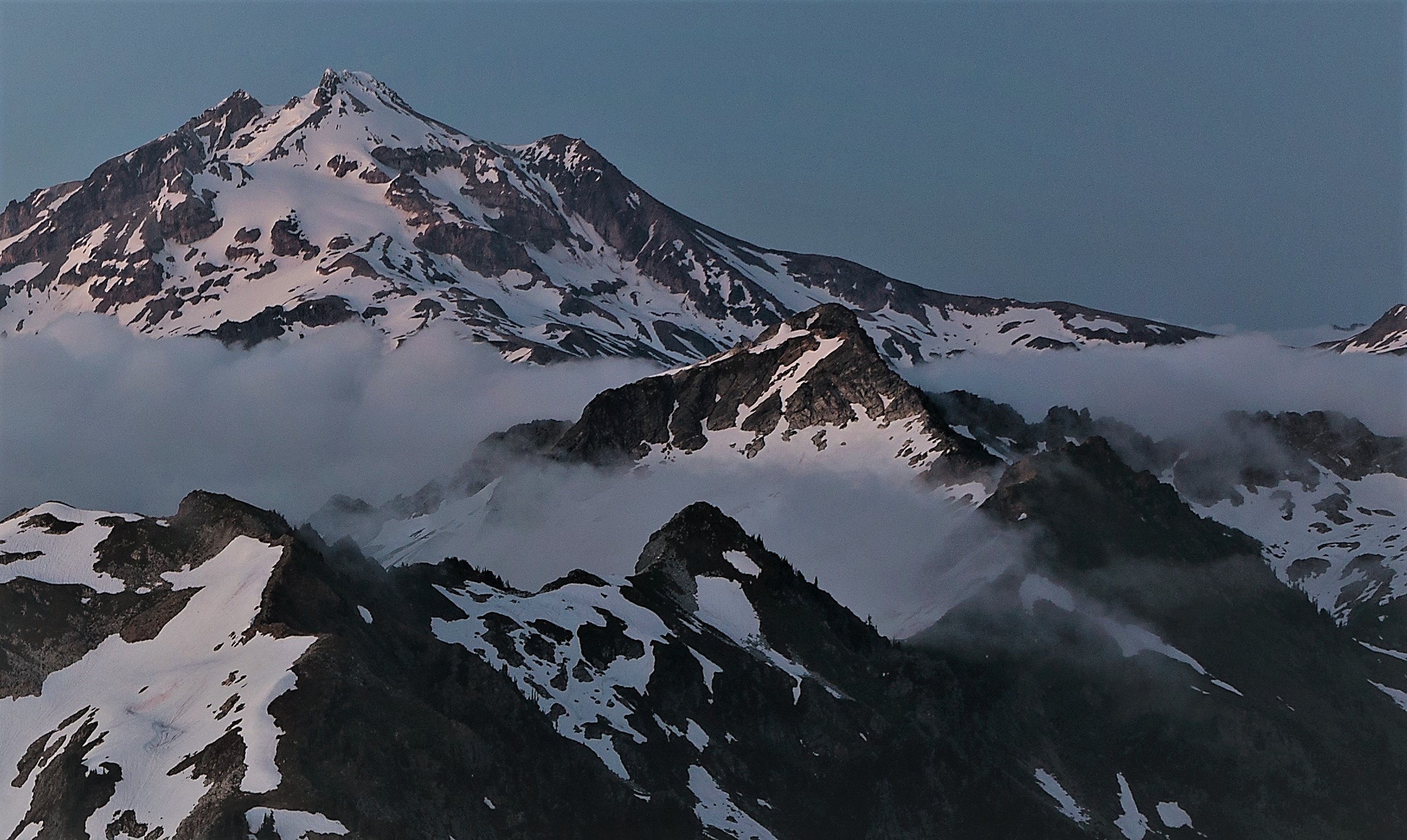Black Mountain (Washington) on:
[Wikipedia]
[Google]
[Amazon]
Black Mountain is a
 The history of the formation of the Cascade Mountains dates back millions of years ago to the late Eocene Epoch. With the North American Plate overriding the
The history of the formation of the Cascade Mountains dates back millions of years ago to the late Eocene Epoch. With the North American Plate overriding the
File:Pugh Mountain and Black Mountain.jpg, Pugh Mountain (distant left) and Black Mountain (right), from the southeast
File:Black Mountain in Glacier Peak Wilderness.jpg, East aspect of Black Mountain, centered.
summit
A summit is a point on a surface that is higher in elevation than all points immediately adjacent to it. The topography, topographic terms acme, apex, peak (mountain peak), and zenith are synonymous.
The term (mountain top) is generally used ...
located in the North Cascades, in Snohomish County of Washington state.
The mountain is situated in the Glacier Peak Wilderness on land managed by Mount Baker-Snoqualmie National Forest. Neighbors include line parent A peak's line parent is the closest higher peak on the highest ridge leading away from the peak's "key col". A col is the lowest point on the ridge between two summits and is roughly synonymous with pass, gap, saddle and notch. The highest col of ...
Kololo Peaks, to the east, Painted Mountain two miles west, and Glacier Peak is to the northeast. Precipitation runoff from the peak drains west into tributaries of the North Fork Sauk River, and east into the White Chuck River. Topographic relief is significant as the summit rises above the White Chuck in two miles. The first ascent of the summit was likely made in 1897 by a survey team including A. H. Dubor, Thomas G. Gerdine, and Sam Strom, who named the mountain for the dark color of its rock. The ascent from the north via Lake Byrne is non-technical.
Climate
Black Mountain is located in the marine west coast climate zone of westernNorth America
North America is a continent in the Northern Hemisphere and almost entirely within the Western Hemisphere. It is bordered to the north by the Arctic Ocean, to the east by the Atlantic Ocean, to the southeast by South America and the Car ...
. Most weather fronts originate in the Pacific Ocean, and travel northeast toward the Cascade Mountains. As fronts approach the North Cascades, they are forced upward by the peaks of the Cascade Range, causing them to drop their moisture in the form of rain or snowfall onto the Cascades ( Orographic lift). As a result, the west side of the North Cascades experiences high precipitation, especially during the winter months in the form of snowfall. Because of maritime influence, snow tends to be wet and heavy, resulting in avalanche danger. Due to its temperate climate and proximity to the Pacific Ocean, areas west of the Cascade Crest very rarely experience temperatures below or above . During winter months, weather is usually cloudy, but due to high pressure systems over the Pacific Ocean that intensify during summer months, there is often little or no cloud cover during the summer.
Geology
The North Cascades feature some of the most rugged topography in theCascade Range
The Cascade Range or Cascades is a major mountain range of western North America, extending from southern British Columbia through Washington and Oregon to Northern California. It includes both non-volcanic mountains, such as the North Cascades, ...
with craggy peaks, spires, ridges, and deep glacial valleys. Geological events occurring many years ago created the diverse topography and drastic elevation changes over the Cascade Range leading to the various climate differences.
 The history of the formation of the Cascade Mountains dates back millions of years ago to the late Eocene Epoch. With the North American Plate overriding the
The history of the formation of the Cascade Mountains dates back millions of years ago to the late Eocene Epoch. With the North American Plate overriding the Pacific Plate
The Pacific Plate is an oceanic tectonic plate that lies beneath the Pacific Ocean. At , it is the largest tectonic plate.
The plate first came into existence 190 million years ago, at the triple junction between the Farallon, Phoenix, and Iza ...
, episodes of volcanic igneous activity persisted. Glacier Peak, a stratovolcano
A stratovolcano, also known as a composite volcano, is a conical volcano built up by many layers (strata) of hardened lava and tephra. Unlike shield volcanoes, stratovolcanoes are characterized by a steep profile with a summit crater and per ...
that is northeast of Black Mountain, began forming in the mid- Pleistocene.Beckey, Fred W. Cascade Alpine Guide, Climbing and High Routes. Seattle, WA: Mountaineers Books, 2008. In addition, small fragments of the oceanic and continental lithosphere called terranes created the North Cascades about 50 million years ago.
During the Pleistocene period dating back over two million years ago, glaciation advancing and retreating repeatedly scoured the landscape leaving deposits of rock debris. The U-shaped cross section of the river valleys is a result of recent glaciation. Uplift
Uplift may refer to: Science
* Geologic uplift, a geological process
** Tectonic uplift, a geological process
* Stellar uplift, the theoretical prospect of moving a stellar mass
* Uplift mountains
* Llano Uplift
* Nemaha Uplift
Business
* Uplif ...
and faulting in combination with glaciation have been the dominant processes which have created the tall peaks and deep valleys of the North Cascades area.
See also
*Geography of the North Cascades
The geography of the North Cascades describes a range of rugged mountains in British Columbia, Canada and Washington (U.S. state), Washington, United States. In Canada, the range is officially named the Cascade Range, Cascade Mountains but is commo ...
Gallery
References
{{reflist Mountains of Washington (state) Mountains of Snohomish County, Washington Cascade Range North Cascades Mount Baker-Snoqualmie National Forest North American 2000 m summits Cascade Volcanoes